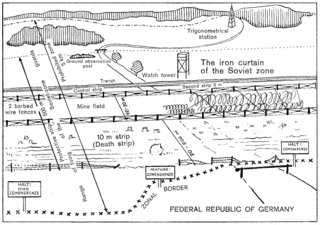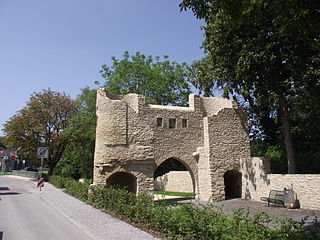 W
WThe Fuchsbau is a military bunker system, located south of the town of Fürstenwalde, Brandenburg, about 55 km (34 mi) east of Berlin.
 W
WFlak towers were large, above-ground, anti-aircraft gun blockhouse towers constructed by Nazi Germany. There were 8 flak tower complexes in the cities of Berlin (3), Hamburg (2), and Vienna (3) from 1940 onwards. Other cities that used flak towers included Stuttgart and Frankfurt. Smaller single-purpose flak towers were built at key outlying German strongpoints, such as at Angers in France, Helgoland in Germany.
 W
WThe fortifications of the inner German border comprised a complex system of interlocking fortifications and security zones 1,381 kilometres (858 mi) long and several kilometres deep, running from the Baltic Sea to Czechoslovakia. The outer fences and walls were the most familiar and visible aspect of the system for Western visitors to the border zone, but they were merely the final obstacle for a would-be escapee from East Germany. The complexity of the border system increased steadily until it reached its full extent in the early 1980s. The following description and the accompanying diagram describe the border as it was around 1980.
 W
WThe Holsten Gate is a city gate marking off the western boundary of the old center of the Hanseatic city of Lübeck. Built in 1464, the Brick Gothic construction is one of the relics of Lübeck's medieval city fortifications and one of two remaining city gates, the other being the Citadel Gate ("Burgtor"). Known for its two-round towers and arched entrance, it is regarded today as a symbol of the city. Together with the old city centre (Altstadt) of Lübeck it has been a UNESCO World Heritage Site since 1987.
 W
WKoblenz Fortress was part of a Prussian fortress system near the city of Koblenz in Germany which consisted of the city fortifications of Koblenz and Ehrenbreitstein and exterior supporting constructions such as entrenchments and forts. Koblenz fortress was built in three stages: 1815-1830, 1859-1868 and 1871-1886. The designers were: Ernst von Aster and Gustav von Rauch. Individual parts of the fortication have been preserved, other parts were demolished over the course of time. For example, in 1890 part of the fortress was declassified, the gates were demolished between 1896-1899 and further structures were demolished in the years 1920-1927.
 W
WThe Kreuztor, built in 1385, is the western gateway to the medieval city center of Ingolstadt. The tower's name is derived from the leper house belonging to the Church of the Holy Cross, which stood to the west of the city walls until its destruction in the Schmalkaldic War in 1546.
 W
WThe Martin city gate is one of three still existing city gates of the German city of Cochem.
 W
WThe Nordertor is an old town gate in Flensburg, Germany, which was built around 1595. Today the landmark is used as a symbol for Flensburg.
 W
WOhrenbrücker Tor is the southwestern gate in the city wall of Ingelheim am Rhein.
 W
WThe Porta Nigra is a large Roman city gate in Trier, Germany. It is today the largest Roman city gate north of the Alps. It is designated as part of the Roman Monuments, Cathedral of St Peter and Church of Our Lady in Trier UNESCO World Heritage Site.
 W
WThe Festungsfront Oder-Warthe-Bogen, also called the Festung im Oder-Warthe-Bogen or Ostwall, and in Polish the Międzyrzecki Rejon Umocniony, MRU, was a fortified military defence line of Nazi Germany between the Oder and Warta rivers, near Międzyrzecz. The part around Międzyrzecz (Meseritz) has been colloquially referred to as the Regenwurmlager. Built in 1934–44, it was the most technologically advanced fortification system of Nazi Germany, and remains one of the largest and the most interesting systems of this type in the world today. It consists of around 100 concrete defence structures partially interconnected by a network of tunnels. Some of the forts and tunnels are available for visiting.